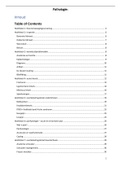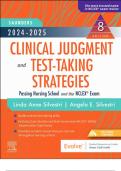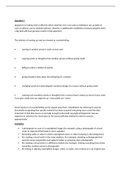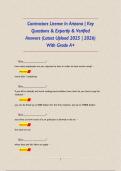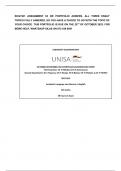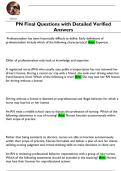Statistics for Psychology.
Descriptive Statistics, F-Scores and the Normal Distribution
1. Descriptive Statistics:
One of the most important foundational things we need to know when doing measurements is
how to make sense of the scores that research participants get on the measures we give them.
One such way of making sense of scores is through descriptive statistics:
Where we try to summarize the data set. This is important because a descriptive
analysis gives us preliminary insights into the whole data set and potentially
highlights measurement errors, outlying scores, overall patterns of responses, as well
as telling us what further questions and analyses are possible.
So, doing a descriptive analysis is often the first step in making sense of quantitative /
measurement information.
Naturally, what kind of descriptive analyses we do depends on the kind of information we
have collected and different summarising procedures are appropriate and applicable to
different types of data / levels of measurement.
One of the most basic descriptive summaries of a data set is a frequency analysis. All that we
are doing in a frequency analysis is counting up how many times each individual score or
value occurs in a given data set. We will do a frequency analysis with nominal/categorical
and ordinal/ranked data. The results of such a summary tell us things like what the most
frequently occurring value in the data set is (i.e. the mode), or what proportion of the sample
we have measured answered in a particular way (i.e. percentages).
When we are using scale data (i.e. interval or ratio measurements), not only can we run a
frequency analysis, but we can also estimate the central tendency and the variability of the
data set. These descriptive analyses tell us two key things about our data set: 1) how the
scores in the data set are spread out amongst the participants (variability), and 2) how the
scores in the data cluster together (central tendency). Most commonly we make use of the
mean (or arithmetic average) to tell us about clustering. The mean is calculated by adding
1
, together all of the values of the scores in the data set and then dividing the result by the
number of cases in the data set. This will give us the mean, or average, score for the data set.
Variability is usually signified by one of two descriptive statistics: 1) the variance; and 2) the
standard deviation. The variance of a data set refers to an estimate of how much, on average,
all of the scores in the data set vary from the mean/average. A high variance will mean a
large spread of scores, where a low variance will signify a tight grouping of scores. Variance
is calculated by subtracting the mean from each individual score in the data set to get a
deviation score for each case, squaring the resulting deviation scores, adding these squared
deviation scores together, and then dividing the result by the total number of cases in the data
set.
The standard deviation is an estimate of how far each individual score is, on average, from
the mean for the data set. We calculate the standard deviation by finding the square root of
the variance. Using the standard deviation allows us to place each individual score in relation
to the mean, and to all of the other scores in the data set.
Example:
So, we can already see how useful this information could be in terms of making sense of an
individual score in a data set if we know the individual score, mean and standard deviation
for that data set. We can on the face of it already tell where the score might lie in relation to
the mean. For example, if your last test result for a class test was 67%, and the class average
for the test was 65% with a standard deviation of 1.8, how well (or poorly) did you do in
relation to your class? Well, if on average each score in the data set is 1.8 away from the
mean of 65% this gives us an average spread of between 63.2% and 66.8%. We can assume
that most of the scores in the data set will fall between these two values, if the data is
normally distributed (but more on this later). We can then see that the score of 67% is above
the 66.8% level, as set by one standard deviation above the mean. So, we know that the score
of 67% is a good score relative to the rest of the class.
This kind of interpretation of the positioning of raw scores in relation to the data set mean is
only possible (even though we can do it more or less intuitively) if we base the comparison of
scores to the mean on the notion of a normally distributed data set.
2. The Normal Distribution:
2
Descriptive Statistics, F-Scores and the Normal Distribution
1. Descriptive Statistics:
One of the most important foundational things we need to know when doing measurements is
how to make sense of the scores that research participants get on the measures we give them.
One such way of making sense of scores is through descriptive statistics:
Where we try to summarize the data set. This is important because a descriptive
analysis gives us preliminary insights into the whole data set and potentially
highlights measurement errors, outlying scores, overall patterns of responses, as well
as telling us what further questions and analyses are possible.
So, doing a descriptive analysis is often the first step in making sense of quantitative /
measurement information.
Naturally, what kind of descriptive analyses we do depends on the kind of information we
have collected and different summarising procedures are appropriate and applicable to
different types of data / levels of measurement.
One of the most basic descriptive summaries of a data set is a frequency analysis. All that we
are doing in a frequency analysis is counting up how many times each individual score or
value occurs in a given data set. We will do a frequency analysis with nominal/categorical
and ordinal/ranked data. The results of such a summary tell us things like what the most
frequently occurring value in the data set is (i.e. the mode), or what proportion of the sample
we have measured answered in a particular way (i.e. percentages).
When we are using scale data (i.e. interval or ratio measurements), not only can we run a
frequency analysis, but we can also estimate the central tendency and the variability of the
data set. These descriptive analyses tell us two key things about our data set: 1) how the
scores in the data set are spread out amongst the participants (variability), and 2) how the
scores in the data cluster together (central tendency). Most commonly we make use of the
mean (or arithmetic average) to tell us about clustering. The mean is calculated by adding
1
, together all of the values of the scores in the data set and then dividing the result by the
number of cases in the data set. This will give us the mean, or average, score for the data set.
Variability is usually signified by one of two descriptive statistics: 1) the variance; and 2) the
standard deviation. The variance of a data set refers to an estimate of how much, on average,
all of the scores in the data set vary from the mean/average. A high variance will mean a
large spread of scores, where a low variance will signify a tight grouping of scores. Variance
is calculated by subtracting the mean from each individual score in the data set to get a
deviation score for each case, squaring the resulting deviation scores, adding these squared
deviation scores together, and then dividing the result by the total number of cases in the data
set.
The standard deviation is an estimate of how far each individual score is, on average, from
the mean for the data set. We calculate the standard deviation by finding the square root of
the variance. Using the standard deviation allows us to place each individual score in relation
to the mean, and to all of the other scores in the data set.
Example:
So, we can already see how useful this information could be in terms of making sense of an
individual score in a data set if we know the individual score, mean and standard deviation
for that data set. We can on the face of it already tell where the score might lie in relation to
the mean. For example, if your last test result for a class test was 67%, and the class average
for the test was 65% with a standard deviation of 1.8, how well (or poorly) did you do in
relation to your class? Well, if on average each score in the data set is 1.8 away from the
mean of 65% this gives us an average spread of between 63.2% and 66.8%. We can assume
that most of the scores in the data set will fall between these two values, if the data is
normally distributed (but more on this later). We can then see that the score of 67% is above
the 66.8% level, as set by one standard deviation above the mean. So, we know that the score
of 67% is a good score relative to the rest of the class.
This kind of interpretation of the positioning of raw scores in relation to the data set mean is
only possible (even though we can do it more or less intuitively) if we base the comparison of
scores to the mean on the notion of a normally distributed data set.
2. The Normal Distribution:
2

